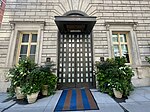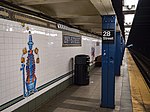Marble Collegiate Church

The Marble Collegiate Church, founded in 1628, is one of the oldest continuous Protestant congregations in North America. The congregation, which is part of two denominations in the Reformed tradition—the United Church of Christ and the Reformed Church in America—is now located at 272 Fifth Avenue at the corner of West 29th Street in the NoMad neighborhood of Manhattan, New York City. It was built in 1851–54 and was designed by Samuel A. Warner in Romanesque Revival style with Gothic trim. The facade is covered in Tuckahoe marble, for which the church, originally called the Fifth Avenue Church, was renamed in 1906.The building was designated a New York City landmark in 1967, and was added to the National Register of Historic Places in 1980.
Excerpt from the Wikipedia article Marble Collegiate Church (License: CC BY-SA 3.0, Authors, Images).Marble Collegiate Church
West 29th Street, New York Manhattan
Geographical coordinates (GPS) Address Nearby Places Show on map
Geographical coordinates (GPS)
| Latitude | Longitude |
|---|---|
| N 40.745555555556 ° | E -73.9875 ° |
Address
West 29th Street 2
10001 New York, Manhattan
New York, United States
Open on Google Maps








